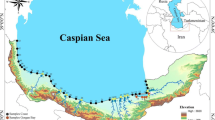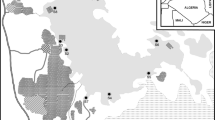Abstract
The purpose of this paper is to determine the concentrations of dissolved heavy metals namely mercury (Hg), lead (Pb), cadmium (Cd), and copper (Cu) and to investigate the relationships between nutrients (nitrate-nitrogen and phosphate) and dissolved heavy metals. For this purpose, the concentrations of dissolved heavy metals were measured through 51 voyages form 1984 to 2006 in the Yangtze river estuary and its adjacent sea. Results analysis showed that dissolved heavy metals were not the main pollutants in the Yangtze river estuary, and the main source of heavy metal contamination was industrial wastewater from terrestrial pollution during the past 20 years. Heavy metal values showed significant abundance in the south branch of the Yangtze River estuary and Hangzhou Bay. In addition, Pb showed negative correlation with nutrients, while the positive correlations between Hg, Cd, and nutrients were shown. The obtained molar ratios, \(\Delta \mbox{Cd}/\Delta \mbox{N} = 1.68 \times 10^{-5}\) and \(\Delta \mbox{Cd}/\Delta \mbox{P} = 1.66 \times 10^{-4}\), are close to those in plankton, showing the biogeochemical behavior and process of dissolved cadmium.
Similar content being viewed by others
References
Bruland, K. W. (1978). Cadmium in northeast Pacific waters. Limnology and Oceanography, 23, 618–625.
Chen, Z. Y., Kostaschuk, R., & Yang, M. (2001). Spatial and temporal distribution of heavy metals on the tidal flats of the Yangtze River estuary, China. Environmental Geology, 40, 742–749. doi:10.1007/s002540000241.
Chen, Z. Y., Saito, Y., Kanai, Y., Wei, T. Y., Li, L. Q., Yao, H. S., et al. (2004). Low concentration of heavy metals in the Yangtze estuarine sediments, China: A diluting setting. Estuarine, Coastal and Shelf Science, 20, 168–177.
Cochran, J. K., Frignani, M., Salamanca, M., Bellucci, L. G., & Guerzoni, S. (1998). Lead-210 as a tracer of atmospheric input of heavy metals in the north Venice Lagoon. Marine Chemistry, 62, 15–29. doi:10.1016/S0304-4203(98)00017-6.
Danovaro, R. (2003). Pollution threats in the Mediterranean Sea: An overview. Chemistry and Ecology, 19(1), 15–32. doi:10.1080/0275754031000081467.
Gearing, J. N., Buckley, D. E., & Smith, J. N. (1991). Hydrocarbon and metal contents in a sediment core from Halifax Harbour: A chronology of contamination. Canadian Journal of Fisheries and Aquatic Sciences, 48, 2344–2354. doi:10.1139/f91-275.
Gorenc, S. A., Kostaschuk, R. A., & Chen, Z. Y. (2004). Spatial variations in heavy metals on tidal flats in the Yangtze estuary, China. Environmental Geology, 45, 1101–1108. doi:10.1007/s00254-004-0968-5.
Irabien, M. J., & Velasco, F. (1999). Heavy metals in Oka River sediments (Urdaibai National Biosphere Reserve, northern Spain): Lithogenic and anthropogenic effects. Environmental Geology, 37, 54–63. doi:10.1007/s002540050360.
Kailasam, N., Subramaniam, N., & Selvam, M. (2001). Analysis of distillery effluent and its effects on the mortality of earthworm Megascolex pumilio. Journal of Ecotoxicology and Environmental Monitoring, 12(1), 21–25.
Li, J. F., & Zhang, C. (1998). Sediment resuspension and implications for turbidity maximum in the Changjiang Estuary. Marine Geology, 148, 117–124. doi:10.1016/S0025-3227(98)00003-6.
Losks K., Wiechua D. (2003). Application of principal component analysis for the estimation of source of heavy metal contamination in surface sediments from the Rybnik Reservoir. Chemosphere, 51, 723–733.
Milliman, J. D., Bearsdley, R. C., Yang, Z. S., & Limeburner, R. (1985). Modern Huanghe-derived mud from the outer shelf of the East China Sea: Identification and potential transport mechanisms. Continental Shelf Research, 4, 175–188. doi:10.1016/0278-4343(85)90028-7.
Qu, W., & Kelderman, P. (2001). Heavy metal contents in the delft canal sediments and suspended solids of the river rhine: Multivariate analysis for source tracing. Chemosphere, 45, 919–925. doi:10.1016/S0045-6535(01)00101-1.
Redfield, A. C. (1934). On the proportions of organic derivations in sea water and their relation to the composition of plankton. In R. J. Daniel (Ed.), James Johnstone memorial volume (pp. 176–192). University of Liverpool Press, Liverpool.
Singh, R. K., Chavan, S. L., & Sapkale, P. H. (2007). Heavy metal concentrations in water, sediments and body tissues of red worm (Tubifex spp.) collected from natural habitats in Mumbai, India. Environmental Monitoring and Assessment, 129, 471–481. doi:10.1007/s10661-006-9377-4.
State Oceanic Administration of China (1998). Marine Monitoring in China (Part 4: Seawater analysis) (pp. 11–35). Standard Press of China (in Chinese).
Wu, G. Y., Tu, W., Shi, C., & Liu, D. L. (1996). Pollution and assessment of heavy metals in the substratum of the tidal beach near the Bai Longgang outlet of wastewater in Pudong new area. Journal of East China Normal University (for Pudong new area), 52–56 (in Chinese).
Yang, S. L. (1999). Sedimentation on a growing intertidal island in the Yangtze River mouth. Estuarine, Coastal and Shelf Science, 49, 401–410. doi:10.1006/ecss.1999.0501.
Zhang, W., Yu, L., Hutchinson, S. M., Xu, S., Chen, Z., & Gao, X. (2001). China’s Yangtze Estuary: I. Geomorphic influence on heavy metal accumulation in intertidal sediments. Geomorphology, 41, 106–205. doi:10.1016/S0169-555X(01)00116-7.
Zitko, V. (1994). Principal component analysis in the evaluation of environmental data. Marine Pollution Bulletin, 28, 718–722. doi:10.1016/0025-326X(94)90329-8.
Author information
Authors and Affiliations
Corresponding author
Rights and permissions
About this article
Cite this article
An, Q., Wu, Y., Wang, J. et al. Assessment of dissolved heavy metal in the Yangtze River estuary and its adjacent sea, China. Environ Monit Assess 164, 173–187 (2010). https://doi.org/10.1007/s10661-009-0883-z
Received:
Accepted:
Published:
Issue Date:
DOI: https://doi.org/10.1007/s10661-009-0883-z




